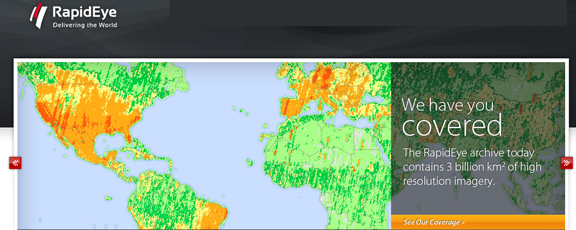...MALAREO project to assist with malaria control programs in countries in southern Africa. While mosquitoes can obviously not be observed via satellite, their habitats, which are considered malaria risk areas, can be. The MALAREO project, funded by the European Commission under FP7, is a mixed European-African consortium which incorporates years of experience in malaria control with the Global Monitoring for Environment and Security (GMES) EO capacity.
Approximately 25,000 square kilometers of RapidEye data was provided via the EC/ESA GMES Space Component Data Access (GSC-DA) covering the MALAREO study area in South Africa, Swaziland and Mozambique. The data was acquired on five different days between July 18 and November 10, 2011, with total cloud cover of less than one percent. RSS—Remote Sensing Solutions GmbH, partner in the project consortium, is responsible for data processing and the development of Earth Observation (EO) products.
Even small water bodies and wetlands play an important role as larval breeding sites for malaria transmitting Anopheles mosquitoes. The identification of water bodies and wetlands are a direct indicator for malaria risk and the distance of local population to water is a major determinant for malaria incidence. In addition, the relation between different land cover types and malaria incidence will be geo-statistically investigated by incorporating other remotely sensed environmental parameters such as elevation, land surface temperature, rainfall estimates, vegetation indices, etc. In addition, it is a hypothesis that recently introduced large-scale irrigated agriculture in the region has caused a change in malaria incidence patterns. High resolution RapidEye data will be used to investigate the relationship between these factors and malaria incidence.
Last month, a meeting with end-users from the Southern African National Malaria Control Programs and the MALAREO project team took place in Durban, South Africa, where RapidEye imagery and the first derived products were presented. The end-users emphasized the benefit of these EO products for malaria control, since these products will greatly improve planning of malaria control measures and will compliment the approach of linking environmental and epidemiological data, which is a first step towards an early warning system for malaria. RapidEye company information link.
Project partners are the South African Medical Research Council and the University of KwaZulu-Natal, South Africa; The National Malaria Control Program of Swaziland, RSS—Remote Sensing Solutions from Germany, The Swiss Tropical and Public Health Institute, and EUROSENSE, the project coordinators, based in Belgium.


